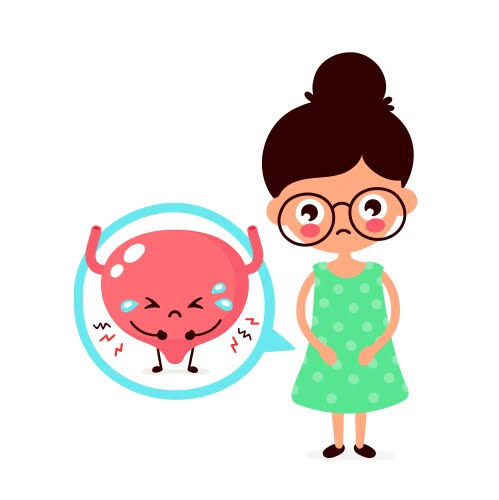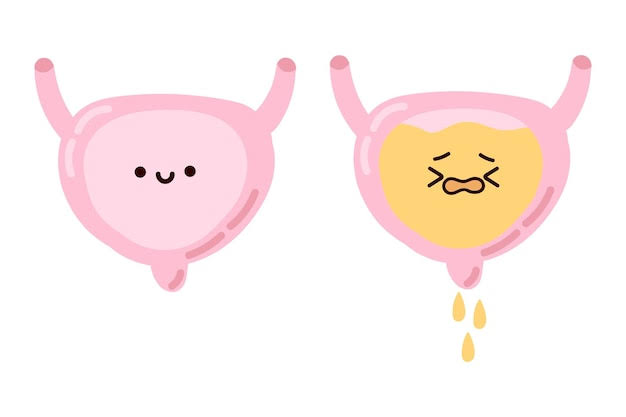Millions of people worldwide suffer from the widespread and frequently embarrassing ailment known as urinary incontinence. Even if talking about it can be delicate, it is important to raise awareness of the issue and look into possible solutions. We will examine the definition, kinds, phases, causes, risk factors, indicators, and symptoms of urine incontinence in this extensive guide. Along with discussing its differential diagnosis, we will also offer advice on how to manage and prevent this ailment generally. We will also discuss the possible advantages of homeopathy as a different kind of treatment for incontinence.

What is Urinary Incontinence?
The inability to regulate the release of pee is the hallmark of urinary incontinence, also known as involuntary urination or bladder leakage. It can take many different forms, ranging from infrequent little leaks to total lack of control over one’s bladder. Urinary incontinence is a symptom of an underlying problem, which may be neurological or physical in nature, rather than an illness unto itself.
The Types of Urinary Incontinence
Urinary incontinence comes in various forms, each having distinct traits of its own:
1. Stress Incontinence: This kind happens when the bladder is compressed by physical actions such as laughing, sneezing, coughing, or heavy lifting, which causes inadvertent pee leaking.
2. Urge Incontinence: Also referred to as overactive bladder, this type is characterized by an intense sudden urge to urinate, which is frequently accompanied by an uncontrollably large urine loss.
3. Overflow Incontinence: This kind leaves pee flowing continuously since the bladder does not empty entirely.
4. Functional Incontinence: This condition, which makes it difficult for a person to use the restroom on time, is not linked to problems with the bladder or urinary system. Instead, it is brought on by physical or mental deficiencies.
5. Mixed Incontinence: This kind is more difficult to treat since it mixes urge and stress incontinence symptoms.
6. Transient Incontinence: This type of urine incontinence is transient in nature, usually brought on by a medical condition or medicine. It usually goes away after the underlying reason is addressed.
The Stages of Urinary Incontinence
Urinary incontinence is classified into distinct stages, each with unique features, and can range in severity:
1. Light Incontinence: People with light incontinence may occasionally have tiny leaks, but they can usually control the problem by changing their way of living.
2. Moderate Incontinence: This stage is characterized by more frequent leaks and may call for the use of protective underwear or absorbent goods.
3. Severe Incontinence: This type of incontinence is difficult to manage or control on its own without medical assistance since it frequently results in substantial urine loss.
Selecting the best course of action for management and treatment of urinary incontinence requires an understanding of the kind and stage of the condition.
The Causes of Urinary Incontinence
Urinary incontinence can result from a number of causes, and the key to successful management is figuring out what is causing it. Typical causes include some of the following:
1. Muscle Weakness: Stress incontinence can be brought on by weak pelvic floor muscles, which are frequently the result of childbearing, aging, or obesity.
2. Nerve Damage: Disorders such as diabetes, sclerosis, or injury to the spinal cord can interfere with the signals sent from the brain to the bladder, which can lead to incontinence.
3. Medication: As a side effect, some drugs have the potential to impair bladder control and cause urine incontinence.
4. Infections: UTIs can aggravate the bladder and result in abrupt, intense impulses to urinate, a condition known as urge incontinence.
5. Prostate Issues: Urinary incontinence in men may be exacerbated by an enlarged prostate or by prostate surgery.
6. Hormonal Changes: The weakening of the urethra lining might result from hormonal changes associated with menopause, which raises the risk of incontinence.
The Risk Factors of Urinary Incontinence
Along with the causes, there are a number of risk factors that could raise your chance of getting urine incontinence:
1. Gender: Because of menopause, delivery, and pregnancy, women are more likely to experience urinary incontinence.
2. Age: Because the muscles and nerves that regulate the bladder deteriorate with age, there is an increased chance of urine incontinence.
3. Obesity: Carrying too much weight can strain the pelvic and bladder muscles, which can lead to stress incontinence.
4. Smoking: Smoking can aggravate incontinence by causing persistent coughing, which weakens the pelvic floor muscles.
5. Family History: Urinary incontinence may run in your family, which raises the possibility of a genetic component.
6. Persistent Constipation: Incontinence can result from the pelvic floor muscles being weakened by straining during bowel movements.
It is vital to comprehend the reasons and risk factors in order to customize an appropriate treatment strategy and take preventative action.
The Signs and Symptoms of Urinary Incontinence
Depending on the kind and stage of the disease, urinary incontinence can present with a variety of signs and symptoms. These are a few typical signs:
1. Frequent Urination: An unexpectedly strong urge to urinate that is frequently accompanied by a feeling of urgency.
2. Pee Leaking: Unintentional pee leaking that occurs during coughing, sneezing, laughing, or lifting.
3. Nighttime Urination: Nocturia, or the repeated awakenings to the need to urinate during the night.
4. Trouble Emptying Bladder: The sensation that, even after urinating, the bladder is not entirely empty.
5. Constant Dribbling: The intermittent release of tiny volumes of pee.
6. Strong Urge to Urinate: An unexpected, overwhelming need to go to the bathroom.
Knowing the particular symptoms you are having will help you identify the kind of urine incontinence you have and inform the treatment options you choose.
Differential Diagnosis of Urinary Incontinence
Differential diagnosis is the process of identifying a medical ailment based on its symptoms from other conditions. It is critical to rule out other diagnoses when treating urine incontinence because similar symptoms might be present in a number of different illnesses. Urinary incontinence can be mimicked by the following conditions:
1. Urinary tract infections, or UTIs: UTIs can make urinating urgent and frequent. These symptoms are frequently alleviated by treating the virus.
2. Interstitial Cystitis: This illness can cause a strong urge to urinate and frequent urine, much like urinary incontinence.
3. Overactive Bladder: An overactive bladder may or may not actually leak, but it is characterized by an abrupt urge to urinate.
4. Neurological Disorders: Syndromes such as sclerosis and Parkinson’s disease can impair bladder control, resulting in symptoms that mimic incontinence.
5. Prostate Issues: Urinary symptoms that resemble incontinence might be caused by an enlarged prostate in males.
6. Pelvic Organ Prolapse: This illness may cause a pelvic pressure sensation and be misdiagnosed as stress incontinence.
Proper diagnosis by a healthcare professional is vital, since it ensures that the most appropriate treatment strategy is chosen. After ruling out other possible reasons, you can concentrate on treating urinary incontinence directly.
General Management of Urinary Incontinence
Depending on the nature and severity of the illness, there are many approaches to managing urinary incontinence. The following are a few general management techniques:
1. Lifestyle Modifications: In moderate cases, a few modest lifestyle adjustments can have a big impact. These could involve managing weight, making dietary changes, and doing pelvic floor exercises.
2. Behavioral Therapies: Methods for enhancing bladder control include bladder training, and Kegel exercises.
3. Medicines: In some circumstances, drugs might be recommended to relax the bladder or strengthen the urethral sphincter.
4. Medical Devices: Urethral implants and pessaries help stop leaks and support the bladder.
5. Surgery: Surgical techniques may be considered in extreme situations or when other therapies are not working.
General Prevention of Urinary Incontinence
Urinary incontinence can not always be prevented, however there are things you can do to lower your risk and take better care of your bladder:
1. Keep Your Weight in Check: Reducing extra weight will help relieve pressure on your pelvic floor and bladder muscles if you are overweight.
2. Remain Hydrated: Make sure you get enough water each day, but try not to drink too much right before bed.
3. Pelvic Floor Exercises: Maintaining strong pelvic floor muscles can be facilitated by performing Kegel exercises on a regular basis.
4. Steer Clear of Irritants: Restrict your consumption of foods high in acidity, alcohol, and caffeine.
5. Handle Chronic Disorders: To lessen the impact of underlying medical disorders on urinary incontinence, make sure they are well-managed if you have diabetes or a chronic cough.
Exploring Homeopathy for Urinary Incontinence
An alternative medicinal strategy that has grown in favor recently is homeopathy. It is predicated on the idea of “like heals like,” which states that a drug that produces symptoms in a healthy individual may be used to alleviate symptoms in a sick person. While homeopathy is controversial in the medical world, some people have found success using homeopathic treatments to address urinary incontinence.
Homeopathic Remedies for Urinary Incontinence
Urinary incontinence can be effectively managed using a variety of homeopathic treatments. Remember that each person will respond differently to these medicines, so speaking with an experienced homeopathic practitioner is essential. Typical homeopathic medicines include the following:
1. Causticum: Use in dry, cold conditions when treating urinary incontinence characterized by gradual, involuntary leakage, particularly during coughing or sneezing.
2. Cantharis: Effective for constant urge to urinate, with painful burning sensations; avoid touch, cold drinks, and coffee.
3. Staphysagria: Recommended for those with ineffectual urges to urinate and a sensation of incomplete bladder emptying; triggered by emotional factors.
4. Clematis Erecta: Suitable for frequent, scanty urination, with constricted urethra and dribbling; pain worsens at night.
5. Sarsaparilla: Excellent for a swollen and sore bladder that is exacerbated by moisture.
6. Senecio Aureus: Recommended in tincture form for youngsters with irritable bladders who have frequent urging and headaches.
7. Sepia: Particularly after childbirth, sepia may be advised for women who experience stress incontinence. It can treat problems that are emotional as well as physical.
8. Lycopodium: Lycopodium is appropriate for people who have a persistent urge to urinate and frequent urination. It might also assist with the feeling that the bladder is not completely emptied.
9. Pulsatilla: When a person experiences urge incontinence together with a strong urge to urinate, pulsatilla is frequently recommended.
10. Nux Vomica: This medication may be taken into consideration if alcohol, caffeine, or spicy meals worsen incontinence.
Working with a qualified homeopathic practitioner is crucial because they are able to perform a thorough evaluation of your disease and suggest the best treatment for your unique set of symptoms.

Conclusion: Empowering Yourself with Knowledge
A common problem that impacts people of all ages and backgrounds is urinary incontinence. By being aware of the different kinds, causes, risk factors, and symptoms of this ailment, you can treat it proactively. While general management and preventive techniques can enhance your quality of life, differential diagnosis guarantees that you receive the appropriate treatment.
Homeopathy is a comprehensive, non-invasive therapeutic option for people looking into alternative therapies. For individualized advice, it is crucial to have an open mind and speak with a licensed homeopathic practitioner.
Never forget that you are not alone. Regain control and lead a satisfying life in spite of urinary incontinence by seeking assistance from medical specialists, making connections with support groups, and investigating other treatment options. You may properly manage your ailment and have a higher quality of life if you have the right information and perseverance.
For any queries, reach out to us at contact@homeopathic.ai





